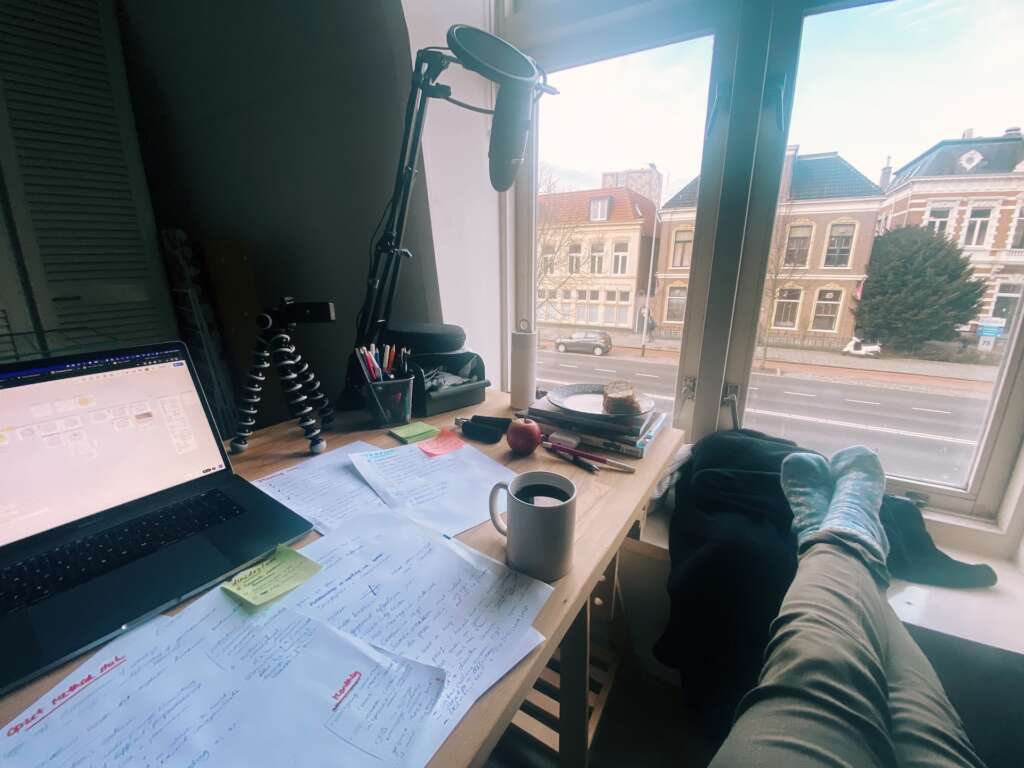Writing an academic article on government services is very different from writing a blog. I have noticed that by now. I just sent the draft of my second article to my supervisor and it feels great.
While writing, I had a lot of help from other researchers who shared on Instagram, Youtube or on their blog how they go about it. So I do something in return of course.
In this blog, I show my writing process, how I prepare and what tools I use.
An update in your mailbox every month about my research? Subscribe to my Dutch newsletter.
A different ball game
I am not writing a book, blog or newspaper article, but a scholarly article. This is a very functional text and very different from what I am used to. You always write for your reader, and in this case my reader wants to know as quickly as possible, “what knowledge is in this piece and can I use it for my research?” There are rules associated with writing a scientific paper, which may also vary by research field.
For example, articles have a set structure: introduction, research question and aim, method, findings, discussion and conclusion. This took a lot of getting used to at first. If I shared a nice anecdote in the discussion, my promoters mercilessly moved it to the findings, or worse, deleted it completely from the article. If I gave even a small hint of the findings and what you could do with them, it was moved to the discussion. But as I plow through many articles myself, I am grateful for that logical format.

In April 2023, based on the data that 7 years of blogging gave me, I wrote an empirical article. Now I’m working on a conceptual piece. I now have a little more freedom to shape the article, but that also makes it immediately more difficult. The argument for my conceptual framework determines the structure of the article, so that argument must be excellent.
I use two articles as a guide for how to build such a conceptual piece. I make a theoretical synthesis of concepts found in the fields of design, services and public administration (Jaakkola, 2020). I bring these concepts together like an architect building a house (MacInnis, 2011).
Building arguments
PhD research is actually an education: with every step you take, you must first learn how to take it. So I took two courses to help me with writing.
- Philosophy of Science at Erasmus University. I learned what makes a good argument and how to check that the structure is sound. We had to analyze others’ texts and dissect them completely.
- Creative tools for scientific writing. For example, how to create overview for yourself, how to extract the main message from a paragraph and write towards it, and how to draw the reader into a text and hold their attention. And also: how to avoid writing those scientific sentences that seem like monstrosities. So that, even though it contains a lot of knowledge, it is also a bit of fun to read your article.
My writing process
After all this preparation, nothing stopped me from keeping my fingers on the keyboard. In January, I had three weeks, nonstop. I had also lost my voice, so I really couldn’t plan anything else.
During the second course, I wrote the introduction to the article, describing the research question, the purpose of the article and the approach to arriving at answers. This introduction covered about 500 words and I discussed it at length with my supervisors. After some scraping, I also sent it to Servsig, a service conference in June. It would be nice if I could give a presentation about the article there; I’ll hear about that later in the spring.
I had already done a lot of reading and made notes. As a library for scientific articles, I use Zotero, which is also useful for keeping track of references while writing. I read through all my notes again. I then created a visual outline in Miro with the main arguments and figures I was going to use, as well as the flow from one point to another.

So the real writing began quite functionally. I started with the main research questions and built the answer step by step in blocks. I added the main sources.
Then I worked out the blocks point by point. Each sentence I placed on a separate line with a number in front of it. The sentences were short and staccato. The important thing was that the argument was clear, and if it was, I marked the most important line. That was the point I was trying to make. I shuffled back and forth some more, looking critically to see if all the sentences were building toward that conclusion. And then I moved on to the next block.
I want to publish in an English-language journal, but I don’t really think in English yet. So I started in Dutch and translated sentences into English when I was satisfied with the structure. I used Deepl as a translation assistant to help me.
Making beautiful sentences
Now it was time to do what I used to call writing: make beautiful sentences. I removed the numbers and wrote the sentences together. Some sentences I added together. Other sentences I worked out and became as many as three sentences. I divided the information into paragraphs and again marked the main message for each paragraph, building toward the conclusion of the entire block. The sentences were much less staccato, but carried full-blown information. And of course I added all the references of the sources I relied on.
For editing, I used Edit.gpt. Mainly for English grammar, but also to improve overall flow. Some adaptations I adopted, others I did not. Then I checked that the sentences ran smoothly and were not too long. I did this by reading the text aloud.
When that was all done, I moved on to the next block. After completing all the blocks within a segment, I read through everything a few times. I watched the transitions from one point to another. I checked that all the research questions were answered and that the whole thing invited further reading.
And so last month I wrote a whopping 8,000 words.

This writing is very different from typing a blog. At first, I had to get used to it tremendously. And it required an awful lot of discipline. With a blog, I usually wait for inspiration, but writing an article went step by step. In December, I resolved to take one step every day, or say, 300 words, so that I would have a draft ready by the end of January. And it succeeded. Even on days without inspiration.
Now what I wrote goes “into the mix. That means receiving feedback from my promoters. They will ask a lot of questions about the argument and rearrange things again. Some of the blocks also need better elaboration, but after 8,000 words I had a toasty brain. I am very curious to see what they come back with.
And about the content itself, because I understand that you are also extremely curious about that, there will be a blog later too :).
References
Jaakkola, E. (2020). Designing conceptual articles: Four approaches. AMS Review, 10(1-2), 18-26.
MacInnis, D. J. (2011). A framework for conceptual contributions in marketing. Journal of Marketing, 75(4), 136-154.
